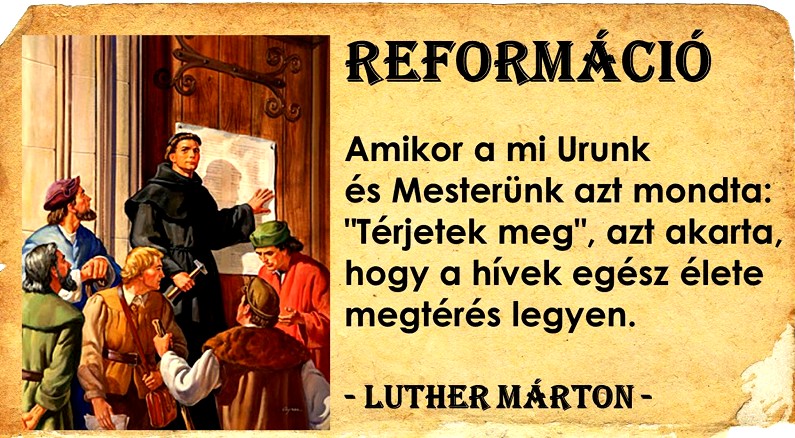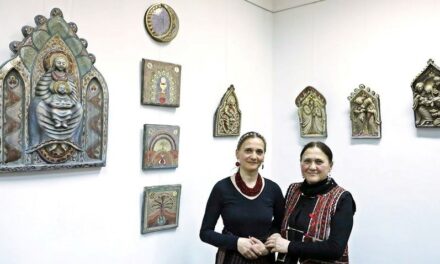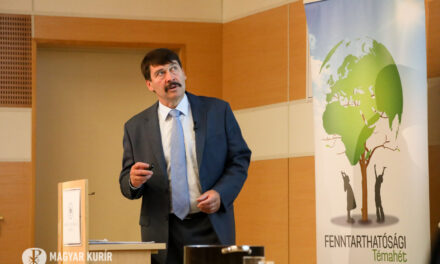" A nation that does not know its past does not understand its present, and cannot create its future!" Europe needs Hungary... which has never let itself be defeated
The spread of the Reformation in Europe
We have already mentioned that at the beginning of the 16th century, the excesses of the Papal Court, the trampling of Christ's teachings into the mud, especially II. During the reign of Pope Gyula and Pope Leo X, it caused great dissatisfaction in several European countries. Márton Luther visited Rome in the very years when the construction of St. Peter's Cathedral began. This required a lot of money, and by order of the Pope, the farewell cards . The fact that the faithful gave money for a note in exchange for the absolution of their sins - which replaced the personal absolution (farewell) by the priest - was outrageous and unacceptable for many. However, the Augustinian monk, Luther, also saw in Rome that most of the clergy had gone mad, the lower clergy were ignorant, the bishops did not care about the affairs of the church, while the pope and his entourage lived a luxurious life. Immorality and corruption were almost natural in the center of the Christian world. The church leaders who followed the secular way of life gave and bought high priestly dignities like some kind of market commodity. Note, not only there. Let's not ignore a fact that determined the economic and political fate of Europe at that time. Fuggers, who were of Swabian (non-Jewish) origin, in addition to the German-Roman emperors, the Habsburg rulers, the Jagiellonian kings and several smaller and larger countries, also controlled Vatican's
money flow They played a decisive role in the sale of farewell cards, but especially in the distribution of the money received.
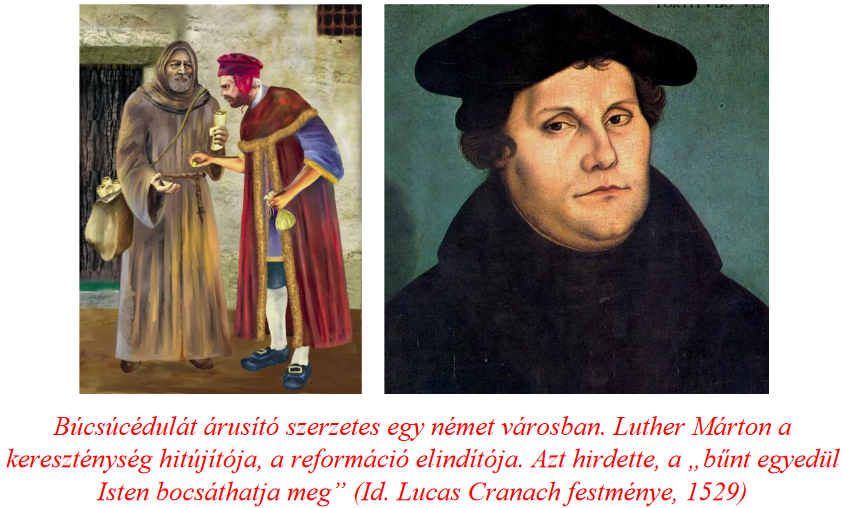
On October 31, 1517, Luther made his views public in 95 points at the University of Wittenberg in Germany. It was part of the essence of the reformation that those who study the text of the Bible and believe in God will be forgiven. There is no need for the intercession of priests, confession and absolution by them. Luther's next step was when he declared that there was no need for either high priests or monks. " One can be saved by faith alone," Luther said. He also condemned priestly celibacy, the veneration of saints and their depiction in churches. He announced that the text of the Bible can really come close to ordinary people if everyone can read it in their mother tongue. It followed that the ceremonies were not conducted in Latin, but in the native language of the given nation. The word of God should reach people directly, and their attention should not be distracted by the decorations, pictures, statues, and splendor of the Greek and Roman Christian churches. However, in addition to the reforms mentioned so far, the essence also appeared, namely the change of ownership of church properties. The Catholic high priests, led by the Pope, naturally did not want to hear about the Lutheran reforms. (One hundred years earlier, the Czech János Husz could still be silenced due to his similar views, although the bloody Hussite wars left a deep mark on the history of Europe.)

Luther, who in 1517 caused the greatest crisis of the Christian Church, which was then already one and a half thousand years old, was excommunicated by Pope Leo X (1513-1521).
Luther had already avoided the fate of János Husz, the stake, because his doctrines divided people in divided Germany, including the powerful princes. The followers of Luther are the Lutherans , who evangelicals . The reformer's teachings spread like wildfire, but some of his followers already deviated from the basic teachings. For example, Tamás Münczer advocated rebaptism in adulthood, which is how the Anabaptist trend was formed. The new doctrines infuriated peasants and princes alike. The bloody German Peasants' War between 1524-1526 was defeated by the princes, who in turn saw Luther's teaching as an opportunity to gain more power and land. (It is no coincidence that Luther was declared a heretic at the imperial assembly in Worms in 1521, and he was forced to flee. He was
received by the Saxon Elector Frederick the Wise New Testament , and here he wrote the inflammatory pamphlets.

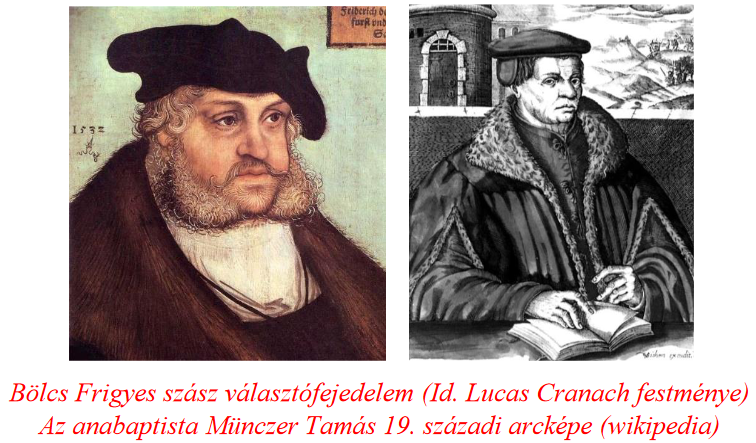
Switzerland was an important station of the Reformation, where the Ulrich Zwingli , took root. The Zurich pastor was killed during the fighting, but the preacher János Kálvin incorporated his teachings into his own teachings. Calvinist Reformation protestant (protest) movement that mobilized the largest masses . According to the "Pope of Geneva", God's will is infinite. According to Calvin, the life of every person - rich or poor - is predetermined. This is the of predestination . Protestant churches rejected church hierarchy. In principle, neither the landlord nor the prince could intervene in the lives of smaller and larger communities - the elected body, presbytery
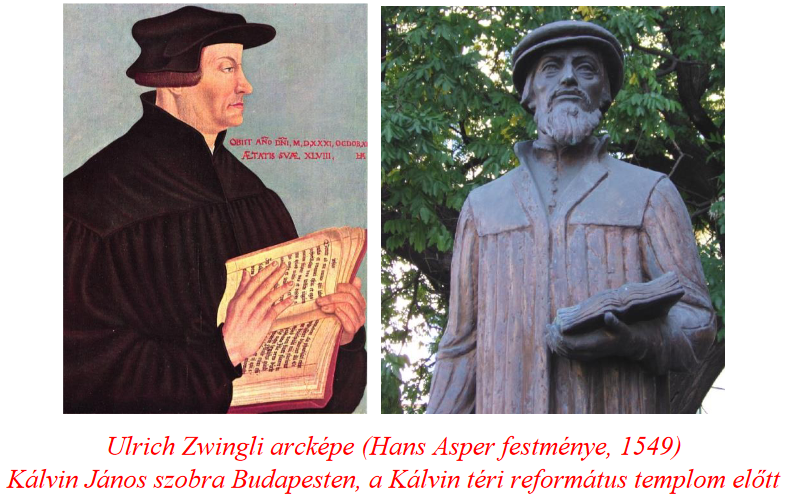
As the increasingly popular Protestant doctrines multiplied, internal contradictions also appeared. Mihály Servet had already denied the Holy Trinity itself. His movement, the antitrinitarian trend, became popular in many places. Unitarian was founded on this model .
In addition to common people (peasants) and princes, the biggest winners of the establishment of Protestant churches were bourgeoisie After all, the new faith opened a free way for all people, which the industrialists and merchants used for the unlimited acquisition of money and power. This is easy to see if you look at 16-17. on the map of Europe in the 19th century. Money, capital, urbanization, the opening of civil schools, and the power of the new elite took deep root where Protestant doctrines were most widely spread. the Scandinavian countries, England, Northern Germany, the Low Countries . The listed Western European states developed and became rich. Transylvania and Eastern Hungary were considered an exception, because even though the Lutheran and Calvinist confessions were widespread here, this did not necessarily bring economic benefits. (The main reasons for this are the Turkish conquest and Habsburg oppression.)

Gutenberg's innovation, book printing, spread The influence of bourgeois development on the history of Europe in the following centuries is beyond dispute. After all, the Bible, books, pamphlets, texts of religious debates, psalms, sheet music, teaching aids, and literary works could not have spread on a mass scale without the printing press. This, in turn, brought with it the necessity of founding schools and setting up printing presses. Even ordinary people could learn to read and write, which resulted in an explosive change not only in the church, but also in worldly life, and the spread of literacy. This was the case throughout Europe, but it was also the case in Hungary.

The antagonisms that were tearing Europe apart, but primarily Germany - which was accelerated and ignited by the spread of the Reformation - came to a temporary halt with the religious peace concluded in Augsburg in 1555
The imperial assembly was convened by Emperor Charles V Both the Catholic and the Protestant sides wanted peace after the many victims, bloody battles and unrest. The negotiations Ferdinand I of Hungary (Károly V's brother), as a result of which the Catholic orders and the Reformed princes reached an agreement. According to the peace, it was not possible to launch an armed attack against the other party in the future, and it was not possible to persecute anyone because of their religion. However, the points of peace were not valid for other religions, it only applied to the Protestant and Roman Catholic denominations.

the principle " Cuius regio, eius religio" ("Whoever owns the land, owns the religion"), the owner of the land could choose which religion he would practice. And the people living on his estate had to follow that. If they were not willing to do so, they had to move to a landlord's estate where they could practice their old religion.
The antecedents of the spread of the Reformation in the Kingdom of Hungary
On the one hand, it was necessary to outline the European history of the development of the Reformation because, although these are known facts, it briefly summarizes the essence of the Great Reformation for the reader less familiar with the subject. On the other hand - on the following pages - during the discussion of the Hungarian reformation, he avoids repetition. We can confidently say that among the countries of Europe in the 16th century, perhaps the largest number of versions of the Reformation took place in our country, which has many explanations. The roots are to be found in the knowledge that the Hussite doctrines took place a hundred years earlier - primarily in the eastern part of the Highlands. We know that the outbreak of the Hussite Wars can be traced back to the role played by the German-Roman Emperor Sigismund of Luxemburg and the King of Hungary in Constance, when the reformer János Husz was burned at the stake.
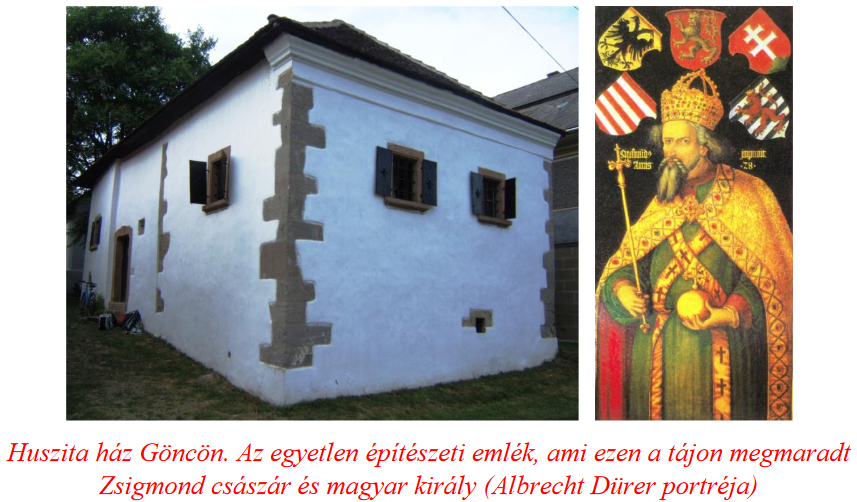
One of the peculiarities of the Reformation in Hungary is that, although there were differences and internal conflicts between the Protestant churches, no bloody warfare took place in the Carpathian basin. János Csohány , professor of theology, preacher of the harmony of European civilization, Hungarian national self-consciousness and Christianity. His research is worth mentioning when discussing the topic. It is important to know the fact that even before Márton Luther entered the scene, the observant Franciscan monks in Hungary were on the side of the poor, which - if not on religious grounds - partly divided society. The Franciscans did nothing but demand church reform. However, this was just enough to favor the work of the reformers. (The Observants represented the stricter, "unsophisticated" branch of the Franciscans. In Hungary, were called
Cheri friends János Kapistzrán , who also distinguished himself in the victory in Nándorfehérvár .
More than 30 percent of the Observant Franciscans active in many European countries lived in the Kingdom of Hungary .
In Turkish times, the Hungarian military leaders entrusted the role of field priests exclusively to Cheri friends.) Their weapon was the preaching of the teachings of Jesus, with which they unwittingly prepared the ground for the spread of the Reformation. They played a big role in the fact that in 1514, the crusade against the Turks turned into a peasant war "on the move". They became credible and popular because they explained social justice based on the words of the Gospel. Erasmus of Rotterdam , the polymath scholar, theologian, practicing priest, who can rightly be considered the forerunner of the Reformation, had a significant impact on the intellectual life of the whole of Europe He remained a Roman Catholic until the end of his life. Like Luther, he was also an Augustinian monk. He sharply criticized the 15-16. the institution of the papacy in the 19th century, scholasticism (a philosophical trend linked to the schools of the Catholic Church), and especially papal supremacy . It is worth knowing that Mária Habsburg, II. Lajos' widow was also greatly influenced by Erasmus' teaching. The previously mentioned György of Brandenburg, to whom the huge Hunyadi estates fell into his lap after his marriage to the widow of János Corvin, was an Erasmist
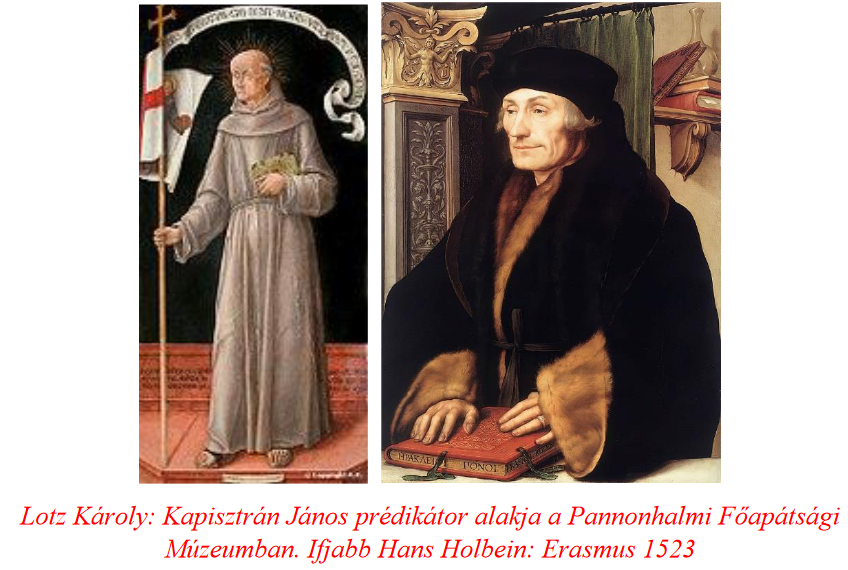
The Hungarian reformation also differed from the reformation efforts of Western countries in that people were free to choose
between the trends of the reformation. in Debrecen in 1567 was considered a milestone . On this II. They adopted the Helvetic Creed, probably just to prove their connection to the West. It is no coincidence that Debrecen became the " Calvinist Rome", i.e. the stronghold of the Hungarian Reformation. (The Orthodox neither in the Balkans nor east of Hungary accepted any branch of the Reformation. It should be noted that the new faith could not take root in Roman Catholic Poland either.)
The spread of the Reformation in Eastern Hungary and Transylvania
The Hungarian reformation also differed from the legal and practical basis of Western European countries in that while the principle of "whoever owns the land belongs to religion" prevailed there, the principle of "Ius patronatus" came into force in Hungary . The latter meant that the patron, supporter, and lord of significantly smaller territorial units – not an entire principality – dictated the religion of the inhabitants of a town, district, or estate. At the same time, however, it can be described that the Roman Catholic religion was dominant in royal Hungary at first, since the will of the Habsburgs prevailed. In Transdanubia, at first, the papal reformed college , as well as the population of the city and its surroundings, took a pioneering role in spreading Calvinist doctrines. In the Highlands, the majority of the Saxon (Zipper) population followed the Lutheran (Evangelical) faith. The situation was similar in Transylvania, as the population of the Saxon cities was also Lutheran. And in the Subjugation, as discussed in section 42, Islam was considered the legal religion. However, for tactical reasons, the Turks tolerated the operation of the Reformed churches, less so the Catholics.

The new religion was able to spread without major obstacles in Eastern Hungary and Transylvania thanks to several reasons. On the one hand, because they were far from Vienna, the Habsburg influence prevailed here less. On the other hand, because large masses of Saxons settled here earlier, who then converted to the "German religion" as one person. Thirdly, the Turks had a military and economic influence primarily on Transylvania, and the Reformed faith and churches were more acceptable to them than the Catholic one. Fourth, because the Hungarians living here also wanted to express their antipathy towards the Habsburgs by abandoning the Catholic faith. The 16-17. In the 19th century, in the eastern parts of the country and in Transylvania, Catholic and Reformed orators engaged in religious debates The battle of orators took place in the Hungarian language in churches and in the public squares of cities. In most places, the Calvinist (Reformed) debating side was successful among the audience.

Parliament of Torda
January 6-13, 1568 The parliament held between 1910 and 1930 not only eased the religious divide between Transylvania and the Kingdom of Hungary (Royal Hungary),
but also set an example for the whole of Europe. The religious reformation that began half a century earlier has already demanded a lot of blood, human tragedy and destruction, and religious antagonisms will flare up even after that. However, the Parliament of Torda set an example for the Christian world by saying that it is possible to live in peace with each other. János Zsigmond , the first prince of Transylvania, which stated that no one can question the freedom and equality of the four religions - the Catholic, the Lutheran, the Reformed and the Unitarian - in the land of Transylvania. Such wide-ranging religious tolerance in the 16th-17th centuries. not a single country in 19th-century Europe recognized it. Later, citizens of Switzerland will be those who create a similar peace in the land of the cantons. (The previously mentioned Peace of Augsburg of 1555 stated the equality of Catholics and Lutherans, but did not allow free choice of religion
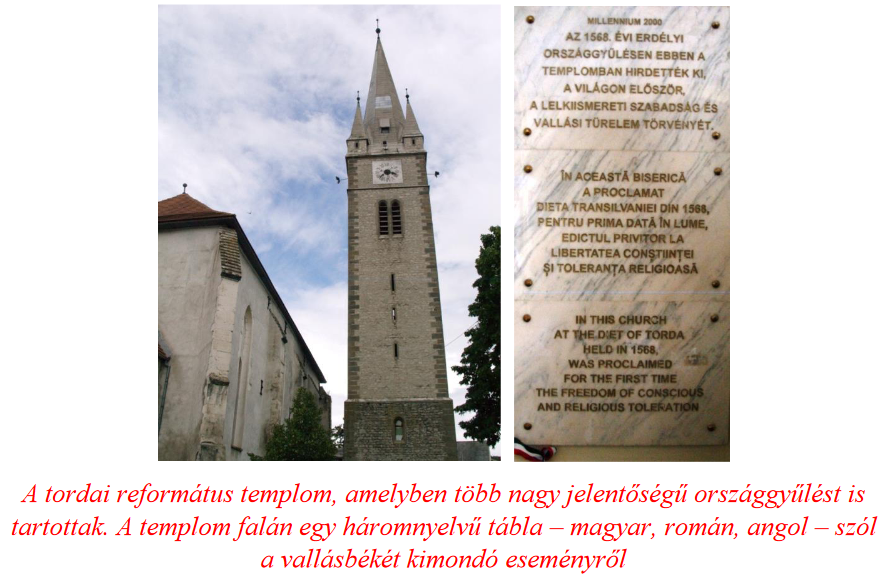
After the Mohács tragedy, the Protestant faith spread rapidly throughout the Carpathian basin, especially in Transylvania and Eastern Hungary. In the Principality of Transylvania, founded in 1542, the Lutheran faith, the German religion, spread in the areas dominated by the Saxons. Most of the Hungarian population followed the Calvinist Reformation , a good example of which is still present in Kalotaszeg and a part of Székelyföld. A significant number of the Reformed the anti-Trinitarian (Trinitarian) trend Ferenc Dávid Among them was the prince, János Zsigmond. In Transylvania, the trend led by Ferenc Dávid became known as Unitarian Among the population of Székelyföld, mainly Csíkszék remained Roman Catholic . It is necessary to mention the of Sabbatarians , who considered the writings of the Old Testament as the basis of their religion. The 16-17. The name of the communities formed at the turn of the century comes from the fact that they held their services on Saturday instead of Sunday. Jews , but they were just like the other Hungarians from Székely, Mezőségy and Cluj.
(Over time, they were absorbed, for example, into the ranks of the Unitarians. The 19th-century successors of the Saturday religion became Adventists
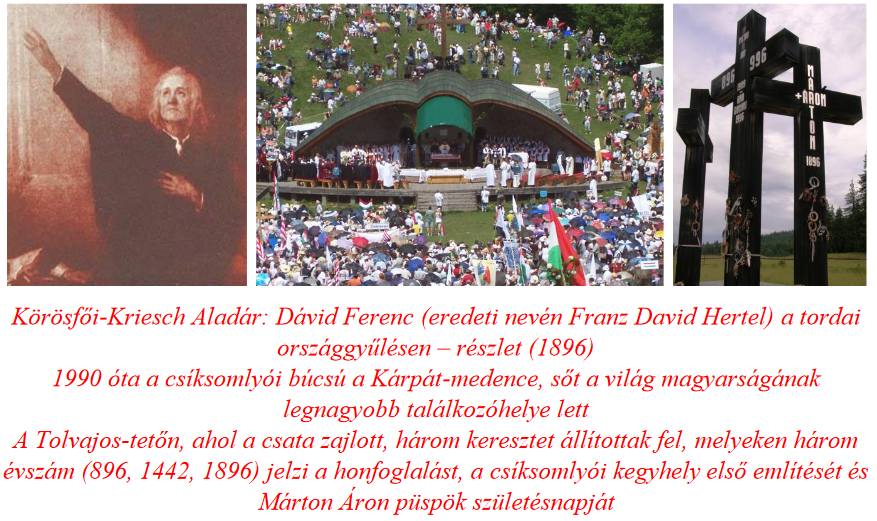
One of the most well-known events in the religious history of Transylvania is connected to the farewell in Csiksomlyo . In the year before the Torda Parliament, in 1567 , János Zsigmond arrived in Székelyföld with a large army to convert the Catholic population of Csíki, Gyergyó and Kászon to the Unitarian faith. The Catholics István Gyergyóalfalvi parish priest, set off for Hargita on Pentecost Saturday. At Tolvajos-tető, the Szeklers clashed with the prince's army and won a brilliant victory. The memory of this is kept by the Czíksomlyó farewell held every year at Pentecost.
The spread of the Reformation in royal Hungary
The tragedy of Mohács affected the whole country, but especially affected the Roman Catholic Church. By killing seven high priests on the battlefield, the Turks literally beheaded the Roman Catholic Church. However, this favored the spread of the Reformation. It was favorable because the parishes were left without management, where the reformers and reformers appeared. The two kings elected in 1526 - János Szapolyai and Ferdinand Habsburg - mostly gave the estates of the archbishops and bishops who fell on the battlefield to secular lords loyal to them. Quite a few of them used their easily acquired church assets to support the Reformation. The often well-intentioned patrons transferred the legacy of the humanist scholars into the Hungarian language when they helped the first Bible translators /Sylvester János and Gáspár Károly/ and set up printing presses for printing the Hungarian-language New Testament and the entire Bible.

In school textbooks and in the public mind, the geographic division of religions lives on in such a way that the Habsburgs and the Kingdom of Hungary ruled by them
remained as one people on the Roman Catholic faith, and the Reformation spread only in the eastern part of the country and Transylvania. However, the reality shows a much more nuanced picture. We mentioned earlier the attachment of Mária Habsburg to the teachings of Erasmus. Miksa Habsburg, who followed Ferdinand although he remained officially Catholic, he was closer to the Reformed doctrines in his faith. This manifested itself, among other things, in the fact that he supported and favored the Lutheran and Calvinist doctrines, which was also a political game. Belonging to Vienna was natural for the Lutheran Saxons in terms of the German language and culture. The fact that the main officials of Hungary also became supporters of the reformation is telling, shaped by the interests. (As a result of the Counter-Reformation, this creed will take a significant turn.)
Mátyás Bíró Dévai, who started out as a fervent Catholic, is one of the initiators of the Hungarian Reformation. Under Melanchthon's personal influence, he became an enthusiastic supporter of humanism, but he embraced Luther's doctrines as well as the Calvinist Reformation. He was subjected to constant persecution throughout his life. He also went to prison in Vienna for his faith.
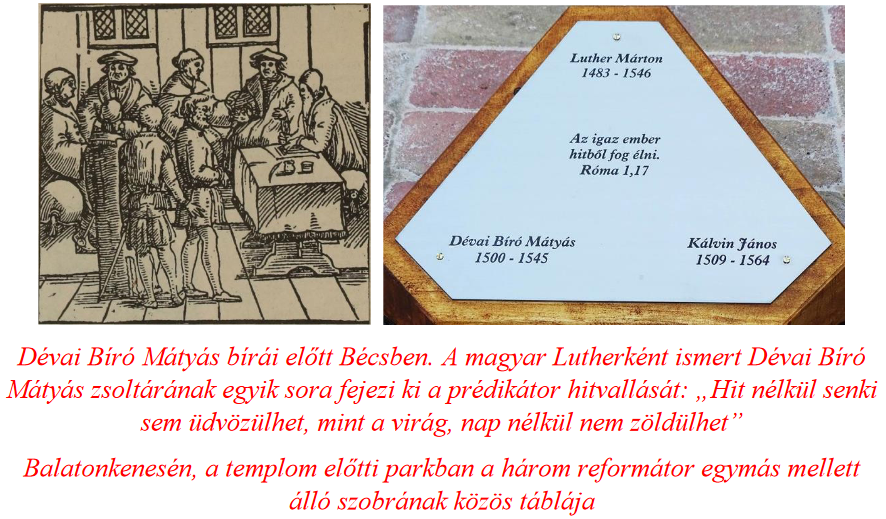
István Kis Szegedi visited many settlements in the country, where he taught, founded churches and preached Calvinist doctrines.
in Csanád, Timisoara, Cegléd, as well as in many cities of the Southern Transdanubia. He was active in Ráckevén in 1572, when he was taken by death.
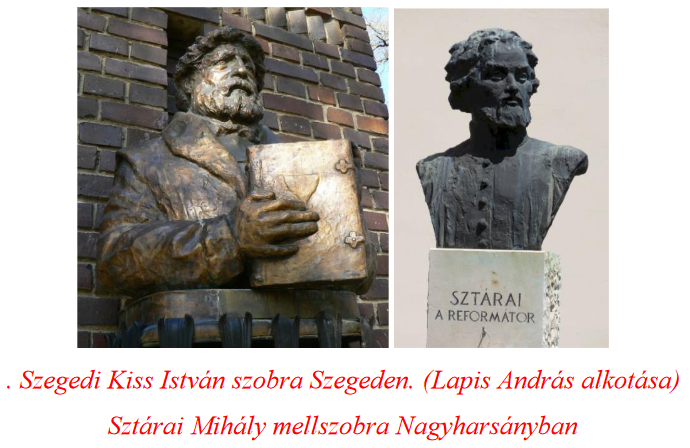
Mihály Sztárai was originally a Franciscan monk, who then became one of the enthusiastic forerunners of the Reformation. The popular, good-humored preacher, the tireless country traveler Sztárai visited Slavonia and worked in Baranya and Tolna. For years, he organized the life of the Reformed communities in the Upland (Kassa, Patak) and Transdanubian (Pápa) cities. He founded about 120 churches, which indicates his activity, spiritual and physical strength.
In the second half of the 16th century, the Hungarians of Tiszahát split between the Lutheran and Calvinist schools of thought at the Councils of Tarcal Torda (1563) and Nagyenyed in Transylvania the Debrecen the Herzegszőllős synod in Southern Transdanubia, now part of Croatia, the Protestant followers of Baranya and Tolna formed separate evangelical and reformed churches.
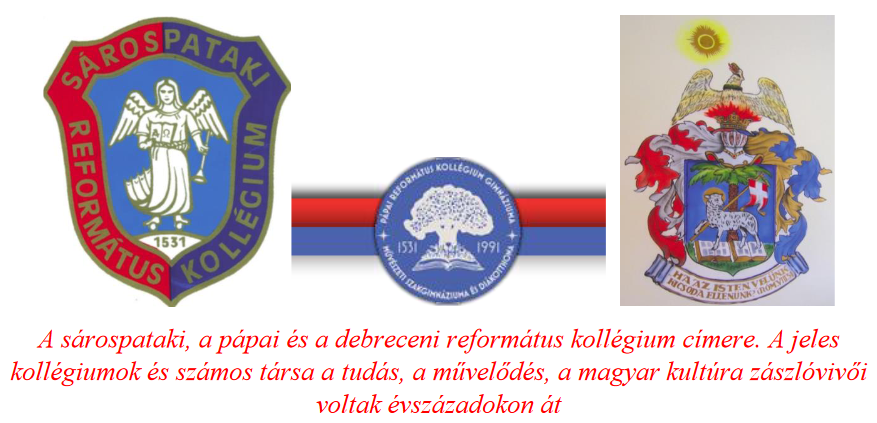
Marxist historiography did not like and even eliminated the " what would have happened if this had not happened" approach and historical conclusions. It is understandable, since this did not favor the more than four-decade period (1945-1990), which broke the 1,100-year natural process of Hungarian history. Nevertheless, let's ask the question: What would have happened if Tamás Bakócz was elected pope in 1513, and not Leo X, the immoral, money-hungry Medici pope who ruined the papacy and sold out the Vatican?
Author: Ferenc Bánhegyi
(Cover image: Hungarian National Archives )
The parts published so far can be read here: 1., 2., 3., 4., 5., 6., 7., 8., 9., 10., 11., 12., 13., 14., 15., 16., 17., 18., 19., 20., 21., 22., 23., 24,, 25., 26., 27., 28., 29/1., 29/2., 30., 31., 32., 33., 34., 35., 36., 37., 38., 39., 40., 41., 42.

